Chapter: Distributed Systems : Synchronization and Replication
Multicast Communication
Multicast Communication
·
Group (multicast) communication: for each of a
group of processes to receive copies of the messages sent to the group, often
with delivery guarantees
·
The set of messages that every process of the group
should receive
·
On the delivery ordering across the group members
·
Challenges
·
Efficiency concerns include minimizing overhead
activities and increasing throughput and bandwidth utilization
·
Delivery guarantees ensure that operations are
completed
·
Types of group
·
Static or dynamic: whether joining or leaving is
considered Closed or open
·
A group is said to be closed if only members of the
group can multicast to it. Reliable
·
Multicast
·
Simple basic multicasting (B-multicast) is sending
a message to every process that is a member of a defined group
Ø B-multicast
(g, m) for each process p ∈ group g,
send (p, message m)
Ø On
receive (m) at p: B-deliver (m) at p
Ø Reliable
multicasting (R-multicast) requires these properties
Ø Integrity:
a correct process sends a message to only a member of the group
Ø Validity:
if a correct process sends a message, it will eventually be delivered
Ø Agreement:
if a message is delivered to a correct process, all other correct processes in
the group will deliver it
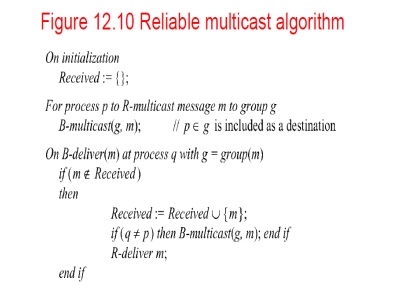
·
Types of message ordering
·
Three types of message ordering
o
FIFO (First-in, first-out) ordering: if a
correct process delivers a message before another, every correct process will
deliver the first message before the other
o
Casual ordering: any
correct process that delivers the second message will deliver the previous
message first
o
Total ordering: if a
correct process delivers a message before another, any other correct process
that delivers the second message will deliver the first message first
·
•Note that
o
FIFO ordering and casual ordering are only partial
orders
o
Not all messages are sent by the same sending
process
o
Some multicasts are concurrent, not able to be
ordered by happened before
o
Total order demands consistency, but not a
particular order
·
Figure 12.12 Total, FIFO and causal ordering of
multicast messages
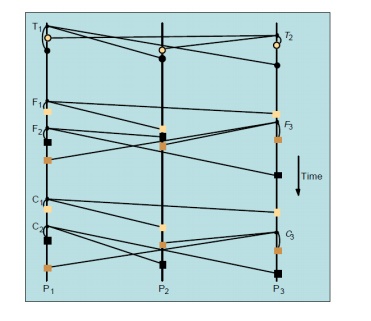
·
Notice
· the
consistent ordering of totally ordered messages T1 and T2,
· the
FIFO-related messages F1 and F2 and
· the
causally related messages C1 and C3 and
· the
otherwise arbitrary delivery ordering of messages
·
Note that T1
and T2 are delivered in opposite
order to the physical time of message creation Bulletin board example (FIFO
ordering)
·
A bulletin board such as Web Board at NJIT
illustrates the desirability of consistency and FIFO ordering. A user can best
refer to preceding messages if they are delivered in order. Message 25 in
Figure 12.13 refers to message 24, and message 27 refers to message 23.
·
Note the further advantage that Web Board allows by
permitting messages to begin threads by replying to a particular message. Thus
messages do not have to be displayed in the same order they are delivered

·
Implementing total ordering
§ The
normal approach to total ordering is to assign totally ordered identifiers to
multicast messages, using the identifiers to make ordering decisions.
§ One
possible implementation is to use a sequencer process to assign identifiers.
See Figure 12.14. A drawback of this is that the sequencer can become a
bottleneck.
§ An
alternative is to have the processes collectively agree on identifiers. A
simple algorithm is shown in Figure 12.15.
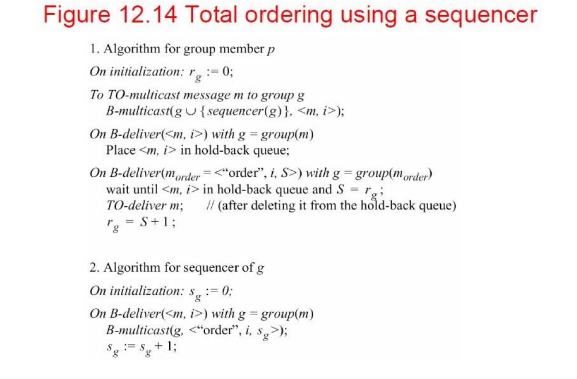
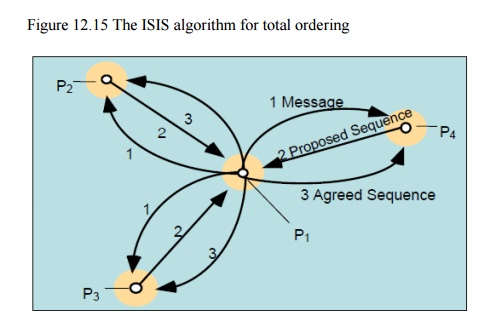
·
Each process q in group g keeps
·
Aq g: the largest agreed sequence number it has
observed so far for the group g
·
Pq g: its own largest proposed sequence number
·
Algorithm for process p to multicast a message m to
group g 1. B-multicasts <m, i> to g, where i is a unique identifier for m
·
Each process q replies to the sender p with a
proposal for the message‘s agreed sequence number of Pq g :=Max(Aq g, Pq g)+1
·
Collects all the proposed sequence numbers and
selects the largest one a as the next agreed sequence number. It then
B-multicasts <i, a> to g.
·
Each process q in g sets Aq g := Max(Aq g, a) and
attaches a to the message identified by i
·
Implementing casual ordering
§ Causal
ordering using vector timestamps (Figure 12.16)
o
Only orders multicasts, and ignores one-to-one
messages between processes
o
Each process updates its vector timestamp before
delivering a message to maintain the count of precedent messages
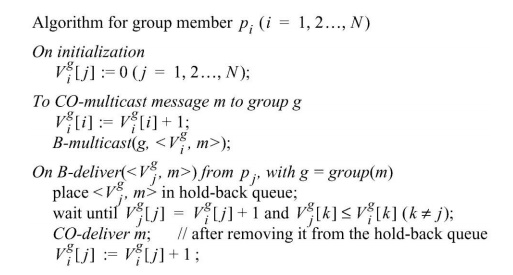
Related Topics